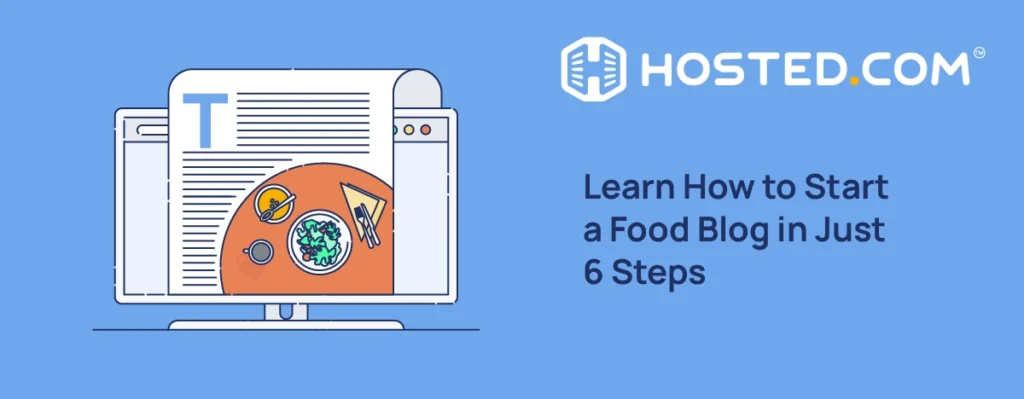
A food blog is a website where you share recipes, cooking tips, and food stories with people who enjoy good meals. It could be for anyone who loves cooking at home, tries new dishes, or reviews restaurants in their city. Whether you’re a beginner in the kitchen or an experienced chef, a food blog gives you the chance to connect with readers and inspire them with your ideas.
This guide teaches you the six main steps to help you start a food blog from scratch. You’ll learn how to pick the correct niche, set up your site with a reliable host or a Website Builder, design it, create content, promote it, and even earn money from it.
We also share important tips to help your blog grow, and answer common questions beginners often have. This way, you’ll have a clear path to launch your food blog successfully.
KEY TAKEAWAYS
- Pick a clear food niche to attract the right audience and give your blog a unique identity.
- Choose reliable hosting and a domain name that’s short, easy to type, and future-proof.
- Use WordPress CMS or a website builder to design your blog with the right theme, layout, and features.
- Write high-quality recipes and reviews with clear steps, detailed information, and strong photos.
- Share personal stories to build trust and make your content more engaging.
- Promote your blog through SEO, social media platforms, and email marketing to grow your audience.
- Monetize with affiliate links, ads, brand collaborations, digital products, or memberships.
- Plan posts using an editorial calendar and keep publishing regular.
- Engage with readers in comments and on social channels to build a loyal community.
TABLE OF CONTENTS
How to Start a Food Blog
Here is our eight-step guide to learning how to start a cooking blog:
Step 1: Establish Your Food Blog Niche
Before you start a food blog, you need to decide what your food blog will focus on. It’s the first most important step, because having a clear niche helps you stand out, attract the right readers, and build a strong identity. Without it, your blog may feel too broad and struggle to connect with people who share your interests.
When choosing your food blogging niche, ensure it matches both your passion and skills. For example, you could write about healthy eating and nutrition, focus on a specific cuisine such as:
- Italian or Japanese.
- Plant-based recipes.
- Baking and desserts.
- Reviews of local food spots.
Each path gives your blog a clear direction and makes it easier for readers to know what they’ll find when they visit.
Adding your personal story also makes your blog more unique. Perhaps you started cooking to follow a healthier lifestyle, or you grew up in a family that passed down traditional recipes. Sharing these details builds trust and helps readers feel closer to you.
However, if you’re unsure where to begin, try brainstorming a list of food topics that excite you the most. Consider what you love to cook, eat, or research, then narrow it down to the one that feels right.
Once you have a focused idea, you’ll find it much easier to create posts that connect with your audience and keep them returning.
Here are quick prompts to explore food blog ideas:
- What recipes do you enjoy cooking most at home?
- Do friends or family often ask you for a specific type of recipe?
- Which cuisines or food traditions inspire you the most?
- Do you want to share reviews of local restaurants or just your own recipes?
- Is there a special diet or lifestyle you follow that others might want to learn about?
Once you choose your niche, you can move to the next step.
Step 2: Choose a Web Host and a Domain Name
To start a food blog smoothly, you’ll need reliable Web Hosting. Good web hosting ensures your site loads quickly, handles images and videos, and is safe from security threats. It should also offer strong customer support and at least 99.9% uptime, so your blog is always available when readers visit.
For an easy setup, you can use Hosted.com® Website Builder that is included with hosting. You also get 200+ ready-made templates, drag-and-drop items, built-in tools for SEO and social media, plus ecommerce features on higher plans. This option is simple and beginner-friendly, since everything is managed in one place.

Another option is WordPress Hosting. This gives you more control while also handling technical tasks, such as automatic updates, security scans, and caching for better speed. WordPress hosting is ideal if you plan to grow your blog over time and need flexibility with themes and plugins.

Next, you’ll need a domain name. A domain is your blog’s web address, so choose one that matches your niche and is easy to remember. Use clear keywords, keep it short, and avoid symbols or numbers that might confuse readers.
Always check that the domain is available before making your final choice, and think long-term so your name won’t limit your blog as it grows.

It’s a good idea to check if the matching usernames are available on social media platforms. This way, your blog’s brand stays consistent everywhere.
Many hosting providers, including Hosted.com®, even offer a free domain registration when you sign up, along with tools to search for available names, transfer old domains, or use AI domain idea generators to spark inspiration.

Step 3: Design Your Blog
When you start a food blog, design plays a big role in how people perceive it. A layout that matches your niche makes it easier to attract readers and keep them engaged.
The good news is that you don’t need to be a designer to build a professional site. With the right blogging platform, you can get started quickly and focus on creating content. However, designing varies based on the platform you choose for your site. How?
Let’s explain it below.
Step 4: Use Hosted.com®’s Website Builder
Hosted.com® makes blog design simple with its drag-and-drop items. You can launch a blog in minutes by following these steps:
First, sign in to the Hosted account. Then, go to the menu on the left and choose Manage Services.

From the options, click Website Builder. This will launch the Website Builder dashboard in a separate window.
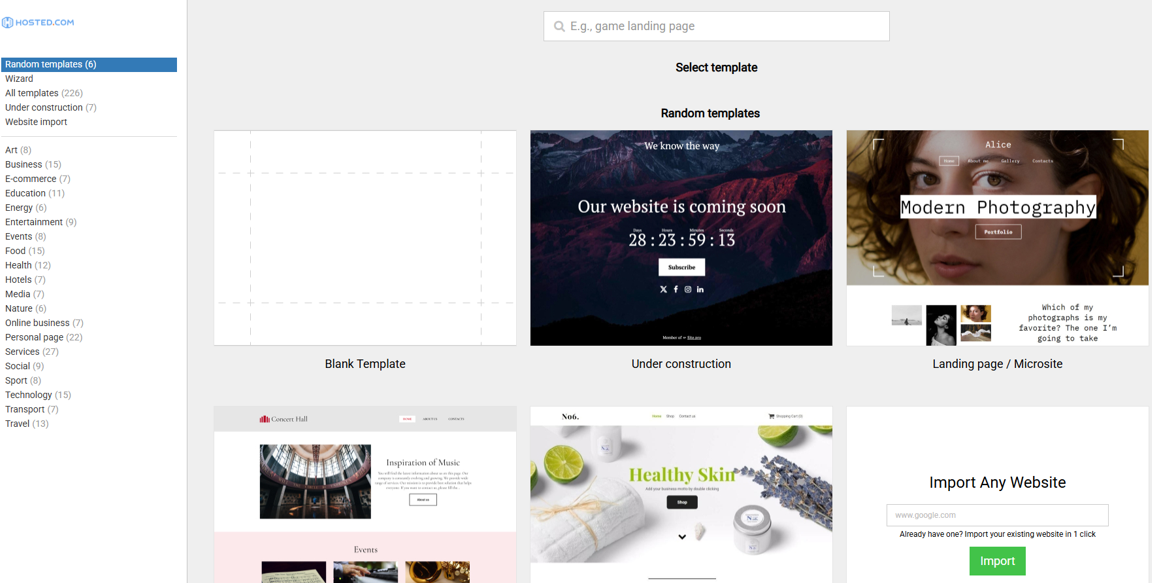
Next, select your desired template.

Create essential pages, such as Home, About, Blog, and Contact.
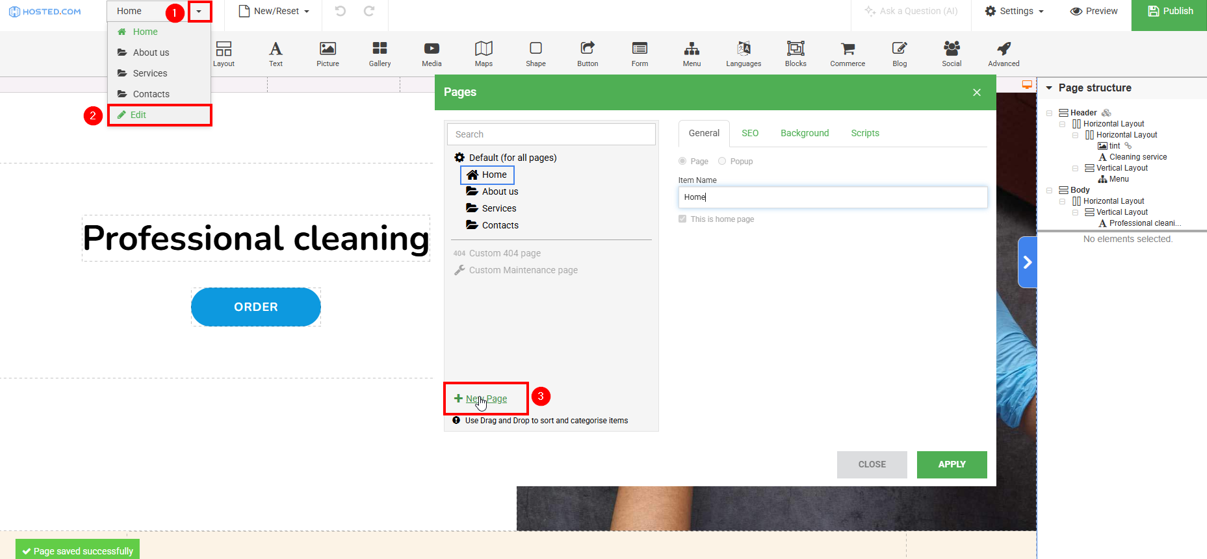
Now, the drag-and-drop editor opens, so you can customize the design and add your blog content. If you prefer more control, you can also browse through dozens of pre-made templates. Filter by category, select a food blog theme, and follow the onboarding checklist for guided editing.
Here are the main elements you’ll want to adjust:
- Text: Rewrite titles, subtitles, and page content.
- Backgrounds: Add food images or adjust the colors for the right mood.
- Logo: Upload your custom brand logo in the header.
- Layout: Edit how your posts appear in the blog list.
- Social Icons: Link your social media accounts in the footer to stay connected with readers.

Step 5: Use WordPress with Hosted.com®
If you’d prefer to use WordPress, Hosted.com® also supports it. Start by installing a food blog theme from the official WordPress directory or a trusted marketplace. Theme developers like Astra offer beautiful templates designed for recipe blogs.
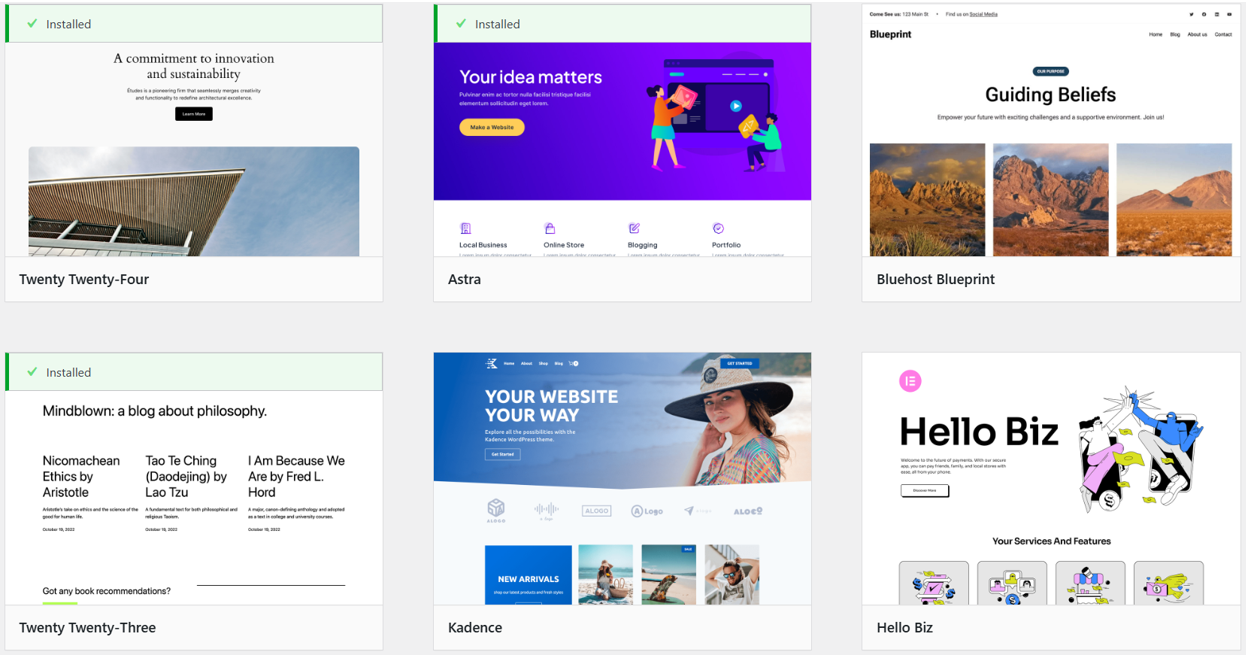
You can then extend your blog’s features with plugins. Recipe plugins like WP Recipe Maker let you share step-by-step recipes in a clear format.

For reader interaction, add a contact form plugin like WPForms.
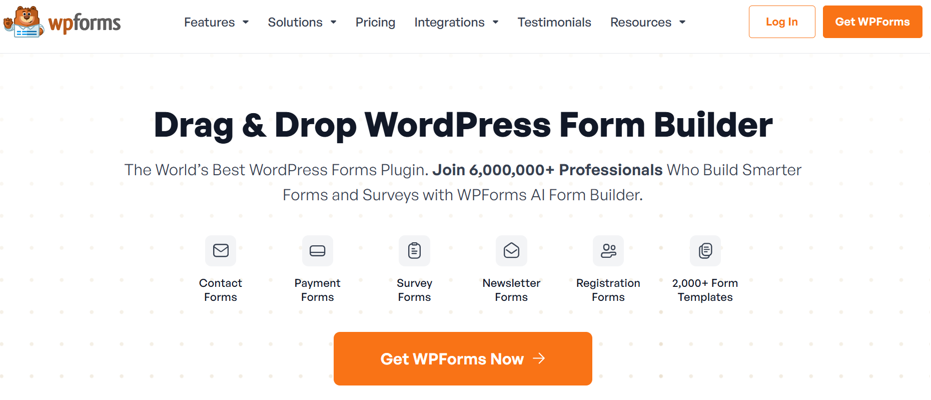
To keep your site safe from spam comments, install Akismet.

With Hosted.com®® hosting and tools, beginners and advanced users can design a blog that looks great, works smoothly, and matches their vision.
Here’s a short comparison table showing the difference between using our Website Builder and WordPress for designing a food blog:
| Features | Hosted.com®® Website Builder | WordPress with Hosted.com®® |
| Ease of Use | Beginner-friendly drag-and-drop editor with AI setup | Requires manual setup but offers more flexibility |
| Setup Time | Fast. A blog can be live in minutes | Slower. Need to install WordPress, theme, and plugins |
| Templates | Dozens of pre-made, AI-personalized food blog templates | Thousands of free and premium themes available |
| Customization | Simple edits (text, images, layouts, backgrounds, logos) | Full customization with themes, plugins, and code |
| Features | Built-in SEO tools, social media integration, and optional ecommerce | Recipe plugins, advanced SEO plugins, contact forms, and more |
| Maintenance | All-in-one solution, updates handled automatically | Requires ongoing updates for WordPress core, themes, and plugins |
| Best For | Beginners who want a quick, hassle-free setup | Bloggers who need more control, flexibility, and scalability |
Step 6: Create High-Quality Content
When you start a food blog, readers will visit your site only if your content is helpful and engaging, and they get to learn something new, so ensure every post provides real value.
If you’re sharing recipes, keep the instructions clear and easy to follow. Write step-by-step directions, include exact measurements, mention cooking times, and explain techniques in simple words. Add small tips that help beginners avoid mistakes, while still providing advanced cooks with new ideas to try.
However, for reviews, go beyond basic descriptions. Talk about the atmosphere of the place, the quality of service, the taste of the food, and the price range. Adding details like location and menu highlights makes your review more useful and easier for people to find through search engines.
Remember, storytelling is another way to connect with readers. Share how you discovered a recipe, the story behind a dish, or your personal experience at a restaurant. This gives your content personality and keeps readers returning for more.
Don’t forget about photography, as it’s just as important as the writing. To photograph, use natural light near a window, keep your composition simple, and focus on the food itself. If you want to take things further, invest in better equipment, or consider hiring a professional photographer to give your posts a professional look.
Remember: high-quality writing and visuals together will make your food blog stand out and encourage readers to share your posts with others.
Here’s a short checklist of must-have elements for every blog post (recipe/review):
For Recipes:
- Clear step-by-step instructions.
- Exact measurements and cooking times.
- Helpful tips for different skill levels.
- Quality photos of each stage or final dish.
For Reviews:
- Name and location of the restaurant/cafe.
- Details on service, taste, and atmosphere.
- Price range or menu highlights.
- Honest opinion with searchable information.
For All Posts:
- Engaging introduction that hooks the reader.
- Personal story or context to build a connection.
- SEO-friendly keywords placed naturally.
- High-quality images with clean composition.
Launch your recipe blog on Hosted.com® with our easy Website Builder or flexible WordPress Hosting plans, designed to get you online fast. Enjoy secure Web Hosting, built-in SEO tools, professional email, and beautifully simple designs that make your brand stand out.
Step 7: Market Your Blog
Once your blog is live, the next step is getting people to find and read it. Here, marketing helps you reach the right audience and turn casual visitors into loyal readers. Here’s how to do this:
- Start with search engine optimization (SEO). Do keyword research to understand what your audience is searching for, and naturally include these terms in blog titles, headings, and content.
- On-page optimization, such as adding meta descriptions,alttext for images, and clear internal links, also improves your chances of ranking higher in search results.
- Social media is another powerful tool for promotion. Focus on the channels that fit your content style:
- Instagram and TikTok are ideal for short food videos and high-quality visuals.
- Facebook works well for longer posts and community groups.
- X (Twitter) is great for quick updates and sharing links.
- Pinterest can drive substantial traffic if you create eye-catching graphics and pin them regularly.
Email marketing also keeps your readers engaged, even after they leave your blog. To do this, offer a simple lead magnet, such as a free recipe eBook or a meal plan, to encourage sign-ups.
Then, create helpful newsletters with new posts, cooking tips, or special updates. Personalizing and segmenting your emails makes them more effective, as readers receive content that suits their interests.
With Hosted.com®, you can also connect professional business email tools to manage your email campaigns smoothly. And when you’re ready to scale, consider using paid ads. With our builder, you can easily integrate with ad platforms; this facilitates testing targeted promotions without extra complexity.

By combining SEO, social media, email, and ads, you’ll build a steady stream of visitors and give your food blog the visibility it needs to grow.
Step 8: Monetize Your Blog
Once your food blog starts attracting regular readers, you can turn it into a source of income. There are several ways to earn money, and the best approach depends on your audience and content style.
Here are some of the ways to earn money with your food blog:
One of the easiest methods is joining affiliate programs. You can recommend cooking tools, ingredients, or kitchen gadgets and earn a commission when readers buy through your links.
Another option is running display ads (PPC) on your site. These ads generate income whenever visitors click on them, making it a passive way to earn as your traffic grows.
You can also work with brands through sponsored posts and collaborations. For example, a food company might pay you to create a recipe using their product. As your blog gains influence, these opportunities become more common.
Additionally, you can sell your own digital products,which is another strong revenue stream. Consider creating recipe eBooks, weekly meal plans, or even online cooking courses. These products require effort, but they can attract a steady income over time.
For loyal readers who want extra value, offer memberships. Create a members-only section that includes premium recipes, step-by-step tutorials, or access to a private community. This builds stronger connections with your audience and provides recurring monthly income.
And, if you wish to explore even more opportunities, consider broader food business ideas, such as offering cooking classes and selling homemade products. With the right mix of strategies, your food blog can grow into a passion project and a profitable business.
To simplify things, we provide a comparison table of monetization methods (effort required, income potential, and best fit) to make this section more actionable for beginners:
| Method | Effort Required | Income Potential | Best For |
| Affiliate Programs | Low. Add links to posts or reviews | Moderate. Depends on traffic and product sales | Beginners who want a simple way to start earning |
| Display Ads (PPC) | Low. Place the ad code once | Low to Moderate. Grows with traffic | Bloggers with steady page views who want passive income |
| Sponsored Posts & Brand Deals | Medium. Create custom content for brands | High. Can be lucrative with a strong audience | Established bloggers with good engagement |
| Digital Products (eBooks, meal plans, courses) | High. Upfront work to create products | High. Recurring sales potential | Bloggers who want to build authority and long-term income |
| Memberships (premium recipes, tutorials, community) | Medium to High–ongoing content needed | High. Monthly recurring revenue | A loyal audience that values exclusive content |
Tips for Running a Successful Food Blog
Starting a food blog is only the first step. To keep it growing, you need to stay consistent and give your readers reasons to return. A few smart habits can make a significant difference in how successful your blog becomes.
- First, create an editorial calendar. It helps you plan your posts in advance so you don’t run out of ideas. By scheduling recipes, reviews, and other content ahead of time, you’ll keep a steady flow of updates without feeling rushed.
- It’s also important to mix your content types. Instead of only posting recipes, try adding restaurant reviews, cooking tips, or personal food stories. This variety keeps your readers interested and attracts different audiences.
- Next, set a posting frequency you can manage. It’s better to publish one high-quality post each week than to rush and post daily with less effort. Quality builds trust, and readers will appreciate content that’s detailed and reliable.
- Finally, always engage with your readers. Reply to their comments, answer questions, and connect with them on social media. Being present shows that you value their support and makes your blog feel more like a community.
With these practices, you’ll start a food blog that not only grows steadily but also builds lasting relationships with your audience.

Find the Perfect Domain Name – AI Domain Name Generator
VIDEO: How to Find the Perfect Domain Name – AI Domain Name Generator
FAQS
Do I need to be a professional chef to start a food blog?
No, you don’t need to be a chef. However, you must enjoy cooking or reviewing food and be willing to share your knowledge clearly to start a food blog. Many successful bloggers are self-taught and share their personal journey.
How to start a recipe blog if I’m a beginner?
If you’re starting, choose a clear niche, acquire reliable hosting with a domain name, and use WordPress or a website builder to design your site. Focus on writing detailed recipes with clear steps, photos, and tips. Promote your posts through SEO and social media, and once you build a loyal audience, you can monetize with ads, affiliate links, or digital products.
How much does it cost to start a food blog?
The cost depends on your choices. With basic hosting and a domain name, you can start for as little as a few dollars per month. If you add premium themes, recipe plugins, or professional photography equipment, the cost will increase, but you can start small and scale later.
How long does it take to grow a food blog?
Building an audience takes time. With regular posting, SEO, and promotion, you can start seeing traffic within a few months. Monetization usually takes longer, often six to 12 months, depending on your consistency and marketing.
Can I make my food blog a full-time business?
Yes, many food bloggers earn a full-time income through ads, affiliate links, sponsored content, digital products, and memberships. Success depends on your niche, consistency, and ability to connect with your readers.
Other Blogs of Interest
– Easily Start a Blog or Content Focused Website
– 6 Best Website Builder for Blogs 2024
– How To Create A Blog for Free: 7 Steps
– Unlocking the Potential of .blog Domains: Tips for Bloggers
– Best Blog Website Templates For A Professional Look
- About the Author
- Latest Posts
Chantél Venter is a creative writer, strategic thinker, and a serious gesticulator. She’s passionate about storytelling, small businesses and bringing color to the world – be it through her words or wardrobe.
She holds a four-year degree in Business and Mass Media Communication and Journalism. She’s been a copywriter and editor for the technology, insurance and architecture industries since 2007 and believes anybody can run a small business successfully. She therefore enjoys finding and sharing the best and most practical tips for this purpose.

















